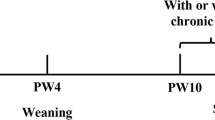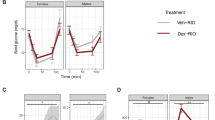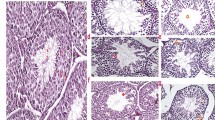Abstract
Both epidemiological and animal studies suggest that adverse environment during pregnancy can change the offspring development programming, but it is difficult to achieve prenatal early warning. In this study we investigated the impact of prenatal dexamethasone exposure (PDE) on sperm quality and function of blood-testis barrier (BTB) in adult offspring and the underlying mechanisms. Pregnant rats were injected with dexamethasone (0.1, 0.2 and 0.4 mg·kg-1·d-1, s.c.) from GD9 to GD20. After weaning (PW4), the pups were fed with lab chow. At PW12 and PW28, the male offspring were euthanized to collect blood and testes samples. We showed that PDE significantly decreased sperm quality (including quantity and motility) in male offspring, which was associated with impaired BTB and decreased CX43/E-cadherin expression in the testis. We demonstrated that PDE induced morphological abnormalities of fetal testicle and Sertoli cell development originated from intrauterine. By tracing to fetal testicular Sertoli cells, we found that PDE dose-dependently increased expression of histone lysine demethylases (KDM1B), decreasing histone 3 lysine 9 dimethylation (H3K9me2) levels of follistatin-like-3 (FSTL3) promoter region and increased FSTL3 expression, and inhibited TGFβ signaling and CX43/E-cadherin expression in offspring before and after birth. These results were validated in TM4 Sertoli cells following dexamethasone treatment. Meanwhile, the H3K9me2 levels of FSTL3 promoter in maternal peripheral blood mononuclear cell (PBMC) and placenta were decreased and its expression increased, which was positively correlated with the changes in offspring testis. Based on analysis of human samples, we found that the H3K9me2 levels of FSTL3 promoter in maternal blood PBMC and placenta were positively correlated with fetal blood testosterone levels after prenatal dexamethasone exposure. We conclude that PDE can reduce sperm quality in adult offspring rats, which is related to the damage of testis BTB via epigenetic modification and change of FSTL3 expression in Sertoli cells. The H3K9me2 levels of the FSTL3 promoter and its expression in the maternal blood PBMC can be used as a prenatal warning marker for fetal testicular dysplasia.
Graphical abstract

This is a preview of subscription content, access via your institution
Access options
Subscribe to this journal
Receive 12 print issues and online access
$259.00 per year
only $21.58 per issue
Buy this article
- Purchase on Springer Link
- Instant access to full article PDF
Prices may be subject to local taxes which are calculated during checkout








Similar content being viewed by others
References
Csaba G. DOHaD (Barker-hipotézis): egy betegségorientált, korszakalkotó, brit eredetű teória, magyar gyökerekkel [DOHaD: a disease-oriented, epoch-making, British-originated theory with Hungarian roots]. Orv Hetil. 2020;161:603–9.
Heard E, Martienssen RA. Transgenerational epigenetic inheritance: myths and mechanisms. Cell. 2014;157:95–109.
Bartolotti N, Lazarov O. CREB signals as PBMC-based biomarkers of cognitive dysfunction: a novel perspective of the brain-immune axis. Brain Behav Immun. 2019;78:9–20.
Chen G, Ai C, Duan F, Chen Y, Cao J, Zhang J, et al. Low H3K27 acetylation of SF1 in PBMC: a biomarker for prenatal dexamethasone exposure-caused adrenal insufficiency of steroid synthesis in male offspring. Cell Biol Toxicol. 2023;39:2051–67.
Li X, Hu W, Li L, Chen Z, Jiang T, Zhang D, et al. MiR-133a-3p/Sirt1 epigenetic programming mediates hypercholesterolemia susceptibility in female offspring induced by prenatal dexamethasone exposure. Biochem Pharmacol. 2022;206:115306.
Yoshida S. Heterogeneous, dynamic, and stochastic nature of mammalian spermatogenic stem cells. Curr Top Dev Biol. 2019;135:245–85.
Bilińska B. Interaction between Leydig and Sertoli cells in vitro. Cytobios 1989;60:115–26.
Magre S, Jost A. Sertoli cells and testicular differentiation in the rat fetus. J Electron Microsc Tech. 1991;19:172–88.
Mruk DD, Cheng CY. The mammalian blood-testis barrier: its biology and regulation. Endocr Rev. 2015;36:564–91.
Skakkebaek NE, Rajpert-De Meyts E, Main KM. Testicular dysgenesis syndrome: an increasingly common developmental disorder with environmental aspects. Hum Reprod. 2001;16:972–8.
Crowther CA, McKinlay CJ, Middleton P, Harding JE. Repeat doses of prenatal corticosteroids for women at risk of preterm birth for improving neonatal health outcomes. Cochrane Database Syst Rev. 2015;2015:CD003935.
Yuan B, Wu W, Chen M, Gu H, Tang Q, Guo D, et al. From the cover: metabolomics reveals a role of betaine in prenatal DBP exposure-induced epigenetic transgenerational failure of spermatogenesis in rats. Toxicol Sci. 2017;158:356–66.
Oldknow KJ, Seebacher J, Goswami T, Villen J, Pitsillides AA, O’Shaughnessy PJ, et al. Follistatin-like 3 (FSTL3) mediated silencing of transforming growth factor β (TGFβ) signaling is essential for testicular aging and regulating testis size. Endocrinology. 2013;154:1310–20.
Oshima Y, Ouchi N, Shimano M, Pimentel DR, Papanicolaou KN, Panse KD, et al. Activin A and follistatin-like 3 determine the susceptibility of heart to ischemic injury. Circulation. 2009;120:1606–15.
Buzzard JJ, Farnworth PG, De Kretser DM, O’Connor AE, Wreford NG, Morrison JR. Proliferative phase Sertoli cells display a developmentally regulated response to activin in vitro. Endocrinology. 2003;144:474–83.
Xia W, Mruk DD, Lee WM, Cheng CY. Differential interactions between transforming growth factor-beta3/TbetaR1, TAB1, and CD2AP disrupt blood-testis barrier and Sertoli-germ cell adhesion. J Biol Chem. 2006;281:16799–813.
Loveland KL, Dias V, Meachem S, Rajpert-De Meyts E. The transforming growth factor-beta superfamily in early spermatogenesis: potential relevance to testicular dysgenesis. Int J Androl. 2007;30:377–84.
Shi M, Whorton AE, Sekulovski N, MacLean JA, Hayashi K. Prenatal exposure to bisphenol A, E, and S induces transgenerational effects on male reproductive functions in mice. Toxicol Sci. 2019;172:303–15.
Pei LG, Zhang Q, Yuan C, Liu M, Zou YF, Lv F, et al. The GC-IGF1 axis-mediated testicular dysplasia caused by prenatal caffeine exposure. J Endocrinol. 2019;242:M17–M32.
Liu M, Zhang Q, Pei L, Zou Y, Chen G, Wang H. Corticosterone rather than ethanol epigenetic programmed testicular dysplasia caused by prenatal ethanol exposure in male offspring rats. Epigenetics. 2019;14:245–59.
Zhang Q, Pei LG, Liu M, Lv F, Chen G, Wang H. Reduced testicular steroidogenesis in rat offspring by prenatal nicotine exposure: Epigenetic programming and heritability via nAChR/HDAC4. Food Chem Toxicol. 2020;135:111057.
Hong J, Chen F, Wang X, Bai Y, Zhou R, Li Y, et al. Exposure of preimplantation embryos to low-dose bisphenol A impairs testes development and suppresses histone acetylation of StAR promoter to reduce production of testosterone in mice. Mol Cell Endocrinol. 2016;427:101–11.
Alamdar A, Xi G, Huang Q, Tian M, Eqani SAMAS, Shen H. Arsenic activates the expression of 3β-HSD in mouse Leydig cells through repression of histone H3K9 methylation. Toxicol Appl Pharmacol. 2017;326:7–14.
Liu M, Chen B, Pei L, Zhang Q, Zou Y, Xiao H, et al. Decreased H3K9ac level of StAR mediated testicular dysplasia induced by prenatal dexamethasone exposure in male offspring rats. Toxicology. 2018;408:1–10.
McGoldrick E, Stewart F, Parker R, Dalziel SR. Antenatal corticosteroids for accelerating fetal lung maturation for women at risk of preterm birth. Cochrane Database Syst Rev. 2020;12:CD004454.
Haram K, Mortensen JH, Magann EF, Morrison JC. Antenatal corticosteroid treatment: factors other than lung maturation. J Matern Fetal Neonatal Med. 2017;30:1437–41.
Moisiadis VG, Matthews SG. Glucocorticoids and fetal programming part 1: outcomes. Nat Rev Endocrinol. 2014;10:391–402.
Kemp MW, Newnham JP, Challis JG, Jobe AH, Stock SJ. The clinical use of corticosteroids in pregnancy. Hum Reprod Update. 2016;22:240–59.
Reagan-Shaw S, Nihal M, Ahmad N. Dose translation from animal to human studies revisited. FASEB J. 2008;22:659–61.
Karl J, Capel B. Sertoli cells of the mouse testis originate from the coelomic epithelium. Dev Biol. 1998;203:323–33.
Martineau J, Nordqvist K, Tilmann C, Lovell-Badge R, Capel B. Male-specific cell migration into the developing gonad. Curr Biol. 1997;7:958–68.
Young JC, Wakitani S, Loveland KL. TGF-β superfamily signaling in testis formation and early male germline development. Semin Cell Dev Biol. 2015;45:94–103.
Zhao T, Tang X, Li D, Zhao J, Zhou R, Shu F, et al. Prenatal exposure to environmentally relevant levels of PBDE-99 leads to testicular dysgenesis with steroidogenesis disorders. J Hazard Mater. 2022;424:127547.
Huang T, Zhang W, Lin T, Liu S, Sun Z, Liu F, et al. Maternal exposure to polystyrene nanoplastics during gestation and lactation induces hepatic and testicular toxicity in male mouse offspring. Food Chem Toxicol. 2022;160:112803.
Xia Y, Sidis Y, Schneyer A. Overexpression of follistatin-like 3 in gonads causes defects in gonadal development and function in transgenic mice. Mol Endocrinol. 2004;18:979–94.
Lui WY, Lee WM, Cheng CY. Transforming growth factor-beta3 perturbs the inter-Sertoli tight junction permeability barrier in vitro possibly mediated via its effects on occludin, zonula occludens-1, and claudin-11. Endocrinology. 2001;142:1865–77.
Qiu X, Cheng JC, Zhao J, Chang HM, Leung PC. Transforming growth factor-β stimulates human ovarian cancer cell migration by up-regulating connexin43 expression via Smad2/3 signaling. Cell Signal. 2015;27:1956–62.
Holmes A, Roseaulin L, Schurra C, Waxin H, Lambert S, Zaratiegui M, et al. Lsd1 and lsd2 control programmed replication fork pauses and imprinting in fission yeast. Cell Rep. 2012;2:1513–20.
van Essen D, Zhu Y, Saccani S. A feed-forward circuit controlling inducible NF-κB target gene activation by promoter histone demethylation. Mol Cell. 2010;39:750–60.
Ciccone DN, Su H, Hevi S, Gay F, Lei H, Bajko J, et al. KDM1B is a histone H3K4 demethylase required to establish maternal genomic imprints. Nature. 2009;461:415–8.
Stewart KR, Veselovska L, Kim J, Huang J, Saadeh H, Tomizawa S, et al. Dynamic changes in histone modifications precede de novo DNA methylation in oocytes. Genes Dev. 2015;29:2449–62.
Moisiadis VG, Matthews SG. Glucocorticoids and fetal programming part 2: mechanisms. Nat Rev Endocrinol. 2014;10:403–11.
Harris A, Seckl J. Glucocorticoids, prenatal stress and the programming of disease. Horm Behav. 2011;59:279–89.
Marciniak B, Patro-Małysza J, Poniedziałek-Czajkowska E, Kimber-Trojnar Z, Leszczyńska-Gorzelak B, Oleszczuk J. Glucocorticoids in pregnancy. Curr Pharmacol Biotechnol. 2011;12:750–7.
Schroeder DI, Schmidt RJ, Crary-Dooley FK, Walker CK, Ozonoff S, Tancredi DJ, et al. Placental methylome analysis from a prospective autism study. Mol Autism. 2016;7:51.
Paquette AG, Houseman EA, Green BB, Lesseur C, Armstrong DA, Lester B, et al. Regions of variable DNA methylation in human placenta associated with newborn neurobehavior. Epigenetics. 2016;11:603–13.
Paquette AG, Lester BM, Lesseur C, Armstrong DA, Guerin DJ, Appleton AA, et al. Placental epigenetic patterning of glucocorticoid response genes is associated with infant neurodevelopment. Epigenomics. 2015;7:767–79.
Howerton CL, Morgan CP, Fischer DB, Bale TL. O-GlcNAc transferase (OGT) as a placental biomarker of maternal stress and reprogramming of CNS gene transcription in development. Proc Natl Acad Sci USA. 2013;110:5169–74.
Keverne EB. Genomic imprinting, action, and interaction of maternal and fetal genomes. Proc Natl Acad Sci USA. 2015;112:6834–40.
Broad KD, Keverne EB. Placental protection of the fetal brain during short-term food deprivation. Proc Natl Acad Sci USA. 2011;108:15237–41.
Maccani MA, Padbury JF, Lester BM, Knopik VS, Marsit CJ. Placental miRNA expression profiles are associated with measures of infant neurobehavioral outcomes. Pediatr Res. 2013;74:272–8.
Zhu Y, Mordaunt CE, Yasui DH, Marathe R, Coulson RL, Dunaway KW, et al. Placental DNA methylation levels at CYP2E1 and IRS2 are associated with child outcome in a prospective autism study. Hum Mol Genet. 2019;28:2659–74.
Arai KY, Tsuchida K, Uehara K, Taya K, Sugino H. Characterization of rat follistatin-related gene: effects of estrous cycle stage and pregnancy on its messenger RNA expression in rat reproductive tissues. Biol Reprod 2003;68:199–206.
Peiris HN, Ponnampalam AP, Osepchook CC, Mitchell MD, Green MP. Placental expression of myostatin and follistatin-like-3 protein in a model of developmental programming. Am J Physiol Endocrinol Metab. 2010;298:E854–61.
Kundakovic M, Gudsnuk K, Herbstman JB, Tang D, Perera FP, Champagne FA. DNA methylation of BDNF as a biomarker of early-life adversity. Proc Natl Acad Sci USA. 2015;112:6807–13.
Csaba G. DOHaD: a disease-oriented, epoch-making, British-originated theory with Hungarian roots. Orv Hetil. 2020;161:603–9.
Acknowledgements
This work was supported by grants from the National Key Research and Development Program of China (No. 2020YFA0803900), the National Natural Science Foundation of China (No. 82030111, U23A20407), and Hubei Province’s Outstanding Medical Academic Leader Program.
Author information
Authors and Affiliations
Contributions
YL designed research, performed researches, and wrote the paper. SJC contributed new reagents and analytic tools. CA, PXY, MF Investigated the literatures. HW got the Funding and reviewed, modified the paper.
Corresponding author
Ethics declarations
Competing interests
The authors declare no competing interests. All institutional and national guidelines for the care and use of laboratory animals were followed.
Supplementary information
Rights and permissions
Springer Nature or its licensor (e.g. a society or other partner) holds exclusive rights to this article under a publishing agreement with the author(s) or other rightsholder(s); author self-archiving of the accepted manuscript version of this article is solely governed by the terms of such publishing agreement and applicable law.
About this article
Cite this article
Liu, Y., Chen, Sj., Ai, C. et al. Prenatal dexamethasone exposure impairs rat blood-testis barrier function and sperm quality in adult offspring via GR/KDM1B/FSTL3/TGFβ signaling. Acta Pharmacol Sin (2024). https://doi.org/10.1038/s41401-024-01244-5
Received:
Accepted:
Published:
DOI: https://doi.org/10.1038/s41401-024-01244-5



